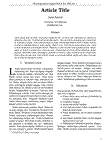Resultados de búsqueda - (((ligur OR ((mile OR made) OR line)) OR ((ligar OR ligas) OR liga)) OR ligue) 1
Materias dentro de su búsqueda.
Materias dentro de su búsqueda.
- 5
- Mexico 5
- México 4
- Scrap 3
- antocianinas 3
- análisis sensorial 3
- mujeres 3
- 5 why 2
- Advertising 2
- Cultura organizacional 2
- Estudiantes 2
- Higher Education 2
- Ishikawa diagram 2
- L. vannamei 2
- Ontology 2
- Ontología 2
- Organizational culture 2
- Pareto Diagram 2
- Policie 2
- Política 2
- Publicidad 2
- Quality Rate 2
- San Luis Potosí 2
- Sensorial 2
- analysis 2
- anthocyanins 2
- antioxidantes 2
- análisis 2
- calidad 2
- camote 2
-
541
-
542
-
543
Elaboración de un pan tipo Danés complementado con harina de amaranto
Publicado 2023Enlace del recurso
Artículo -
544
-
545
-
546
-
547
MANEJO DEL FUEGO EN HUMEDALES DE LA RESERVA DE BIÓSFERA LA ENCRUCIJADA
Publicado 2024Enlace del recurso
Artículo -
548
Respuesta antioxidante de Yarrowia lipolytica en ausencia del gen CAT3
Publicado 2018Enlace del recurso
Tesis -
549
Estudio de la muerte celular inducida por el Immunepotent CRP® en líneas celulares de cáncer de mama y su efecto en combinación con ciclofosfamida o epirubicina.
Publicado 2018“…First, we analyzed cell death, cell morphology, and mitochondrial damage induced by I-CRP in both cell lines. Results showed that I-CRP induces cell-death and cell morphology alterations, loss of mitochondrial membrane potential, and ROS production. …”
Enlace del recurso
Tesis -
550
Respuesta antioxidante de Yarrowia lipolytica en ausencia del gen CAT3
Publicado 2018Enlace del recurso
Tesis -
551
Estudio de la muerte celular inducida por el Immunepotent CRP® en líneas celulares de cáncer de mama y su efecto en combinación con ciclofosfamida o epirubicina.
Publicado 2018“…First, we analyzed cell death, cell morphology, and mitochondrial damage induced by I-CRP in both cell lines. Results showed that I-CRP induces cell-death and cell morphology alterations, loss of mitochondrial membrane potential, and ROS production. …”
Enlace del recurso
Tesis -
552
-
553
Global Trends in Aquaculture and Feed Ingredient Use in Compound Aquafeeds
Publicado 2013“…By region, Asia accounted for over 91.2 percent of total global aquaculture production in 2011 (APR 8.46 percent since 1984), followed by the Americas at 3.53 percent (APR 7.59 percent), Europe at 3.20 percent (APR 3.99 percent), Africa at 1.84 percent (APR 14.82 percent), and Oceania at 0.25 percent (APR 9.02 percent).In terms of the major farmed species groups in 2011, finfish accounted for 41.6 million tonnes or 49.8 percent of total global aquaculture production in 2011 (valued at US $ 83.6 billion, with over 102 reported fish species, and production growing at an average APR of 8.85 percent since 1984), followed by aquatic plants at 21.0 million tonnes or 25.1% of total global production (valued at US $ 5.5 billion, with 12 reported aquatic plant species, and production growing at an average APR of 7.16 percent since 1984), molluscs at 14.4 million tonnes or 17.2 percent of total global production (valued at US $ 15.3 billion, with 27 reported mollusk species, and production growing at an average APR of 7.17 percent since 1984), and crustaceans at 5.9 million tonnes or 7.0 percent of total global production (valued at US $ 28.4 billion, with 15 reported crustacean species, and production growing at an average APR 13.1 percent since 1984; FAO, 2013).The total production of the major finfish and crustacean species groups fed industrially compounded or farm-made aquafeeds was reported to be 40.57 million tonnes in 2011 (FAO, 2013), with total global industrial compound aquafeed production estimated at approximately 35.75 million tonnes; the major compound feed fed species groups including: Chinese carp at 11.76 million tonnes (excluding silver carp and big head carp) with an estimated total compound aquafeed requirement of 10.19 million tonnes; Tilapia at 3.96 million tonnes with an estimated total compound aquafeed requirement of 5.79 million tonnes or 16.2 percent of total global compound aquafeed production;Shrimp at 3.93 million tonnes with an estimated total compound feed requirement of 5.54 million tonnes or 15.5 percent of total global compound aquafeed production; Catfish at 3.38 million tonnes with an estimated total compound feed requirement of 3.70 million tonnes or 10.3 percent of total global compound aquafeed production; Marine fish at 2.01 million tonnes with an estimated total compound feed requirement of 2.82 million tonnes or 7.9 percent of total global compound aquafeed production; Other freshwater and diadromous fish at 1.94 million tonnes with an estimated total compound feed requirement of 1.24 million tonnes or 3.5 percent of total global compound aquafeed production; Salmon at 1.93 million tonnes with an estimated total compound feed requirement of 2.51 million tonnes or 7.0 percent of total global compound aquafeed production; Freshwater crustaceans at 1.67 million tonnes with an estimated total compound feed requirement of 1.71 million tonnes or 4.8 percent of total global compound aquafeed production; Milkfish at 891,407 tonnes with an estimated total compound feed requirement of 820,000 tonnes or 2.3 percent of total global compound aquafeed production; Trout at 791,959 tonnes with an estimated total compound feed requirement of 1.03 million tonnes or 2.9 percent of total global compound aquafeed production; Eel at 255,284 tonnes with an estimated total compound feed requirement of 392,000 tonnes or 1.1 percent of total global compound aquafeed production in 2011.In terms of feed ingredient usage, the compound aquafeed sector still remains the largest consumer of fishmeal and fish oil, aquaculture consuming 78 percent of total global fish oil production in 2011 (major aquaculture species group consumer being salmonids at 66 percent followed by marine fish at 17 percent) and 68% of total global fishmeal production in 2011 (major aquaculture species group consumer being crustaceans at 30 percent, followed by salmonids at 22 percent, and marine fish at 21 percent; Dr Andrew Jackson, personal communication, The Marine Ingredients Organization, http://iffo.net). …”
Enlace del recurso
Artículo -
554
Resistencia de raíces en especies nativas para la estabilidad de suelos relacionados con la prevención de desastres.
Publicado 2017“…The selection of species considered for this study was made based on their native characteristics and presence on slopes. …”
Enlace del recurso
Tesis -
555
Resistencia de raíces en especies nativas para la estabilidad de suelos relacionados con la prevención de desastres.
Publicado 2017“…The selection of species considered for this study was made based on their native characteristics and presence on slopes. …”
Enlace del recurso
Tesis -
556
-
557
Ibero–American Consensus on Low- and No-Calorie Sweeteners: Safety, Nutritional Aspects and Benefits in Food and Beverages
Publicado 2018“…The goal of this Consensus was to provide a useful, evidence-based, point of reference to assist in efforts to reduce free sugars consumption in line with current international public health recommendations. …”
Enlace del recurso
Artículo -
558
La violencia contra las mujeres: su erradicación como objetivo mundial
Publicado 2023Enlace del recurso
Artículo -
559
Un modelo de gestión: experiencia de innovación en la formación de ingenieros
Publicado 2023Enlace del recurso
Artículo -
560
Recent rapid rise of a permethrin knock down resistance allele in Aedes aegypti in México
Publicado 2009“…Methods and Findings: A total of 81 field collections containing 3,951 Ae. aegypti were made throughout Me´xico from 1996 to 2009. These mosquitoes were analyzed for the frequency of the Ile1,016 mutation using a melting-curve PCR assay. …”
Enlace del recurso
Artículo


